Sales tracking gives you an overview of key sales metrics. That way, you can maximize your sales performance.
Loads of customer data, spreadsheets, confusing dashboards, and zero actionable insights — this is what sales tracking looks like for many companies.
But it doesn't have to be that way in 2024. Today, there are many types of sales tracking solutions to help you harness your sales data.
Don’t know where to start? This guide will help you add sales tracking to your CRM sales management strategy.
Sales tracking: Table of contents
What is sales tracking?
Sales tracking is the process of collecting and analyzing data throughout your sales funnel. It involves monitoring multiple aspects of the sales process, including how prospects flow through the pipeline, sales cycle length, sales rep performance, etc.
The more data you have at your disposal, the better equipped you'll be to make informed decisions that drive sales success.
5 Types of sales tracking reports
You don’t need dozens of spreadsheets to establish a successful sales strategy. These five sales reports are key to streamlining your team's process and achieving your sales goals.
Sales pipeline
The sales pipeline is the visual representation of your prospect journey. It’s typically divided into stages, such as:
- Lead generation or prospecting
- Qualification
- Nurturing
- Meeting
- Proposal
- Closed won/Lost
These stages represent the steps a prospect takes along their journey toward becoming a paying customer. The specific stages may vary depending on your unique sales process and product.
Tracking your pipeline allows you to see how many prospects are in each stage and identify any bottlenecks that might be slowing down sales.
Further reading: 8 Winning Strategies to Generate Warm Leads
How to track your sales pipeline
While you may track a sales pipeline with spreadsheets, a CRM system or a dedicated sales tracking tool can simplify the process.
These platforms offer visual pipeline management features, allowing you to drag and drop prospects between stages and see real-time progress.
Later in the article, we'll recommend specific sales tracking solutions. Now, let's see how to set up a pipeline in Brevo:
- Go to Deals > Settings > Deals and Pipelines settings > Manage your pipeline settings and click Create a New Pipeline.
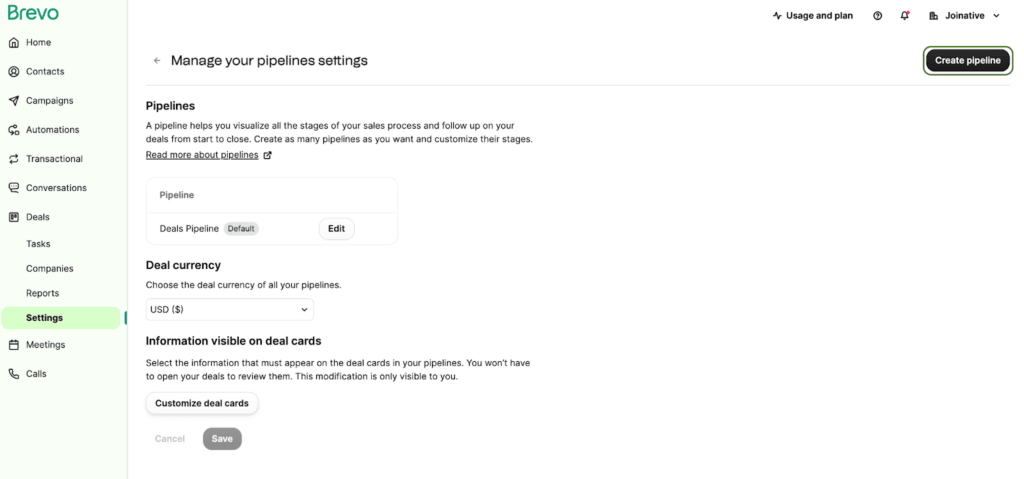
Creating a new deal pipeline in Brevo
- Determine distinct steps in your customer's journey. Then create corresponding stages in your software.
- Allocate the win probability score to each stage. The score estimates how likely sales leads in this stage are to convert and helps the system estimate your future revenue.
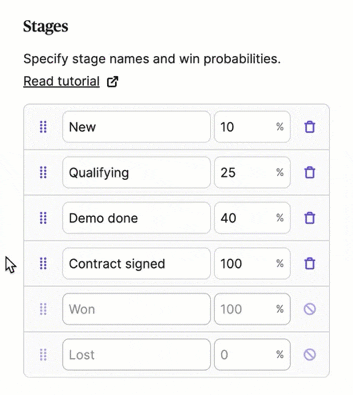
Specifying pipeline stages and win probabilities in Brevo
- Click Create, and you’re all set.
Note: Brevo also offers a default pipeline with customizable stages in all plans. For multiple pipelines, you'll need the Sales Platform Pro plan.

The default sales pipeline in Brevo
Deal tracking
Pipeline tracking gives you an overview of the state of your sales process. But it’s not granular enough to provide insights into individual sales opportunities. That's where deal tracking comes in.
What’s the difference between a deal and a pipeline?
While sales pipeline tracking gives you a broader view of how prospects move through your sales process, deal tracking focuses on individual sales opportunities.
One deal represents one opportunity. It’s usually triggered by a new lead or prospect indicating interest in your offer.
Each deal typically includes information like:
- Prospect details (contact, company)
- Associated products/services
- Deal value
- Current stage in the pipeline
- Progress notes and related communication
The most difficult part of deal tracking is deciding when to create a new deal record. Create a deal too early, and you might clutter your pipeline with leads that won't convert. Wait too long, and you risk missing out on critical data and timely nurturing.
Typically, the best time to create a new deal record is when a lead submits a contact form or requests a demo. In Brevo, you can set up an automated workflow to create a new deal whenever a lead takes a predefined action.

Automatically creating a new deal in Brevo
But just because someone shows interest in your offering doesn't guarantee it aligns perfectly with their needs. It's wise to check pre-defined qualification criteria such as:
- BANT (Budget, Authority, Need, Timeline). Does a prospect have an actual need, decision-making power, and resources to purchase?
- Company fit. Does the prospect align with your ideal customer profile in terms of size, industry, etc.?
- Pain points. Has the prospect expressed specific challenges that your solution effectively addresses?
If your lead meets the criteria, it’s time to create a new deal manually. In Brevo (or your chosen CRM software), creating a new deal for a qualified lead takes just a few clicks.
Simply select existing contacts and companies (or create new ones if needed). Then specify the deal details in a single, user-friendly form.
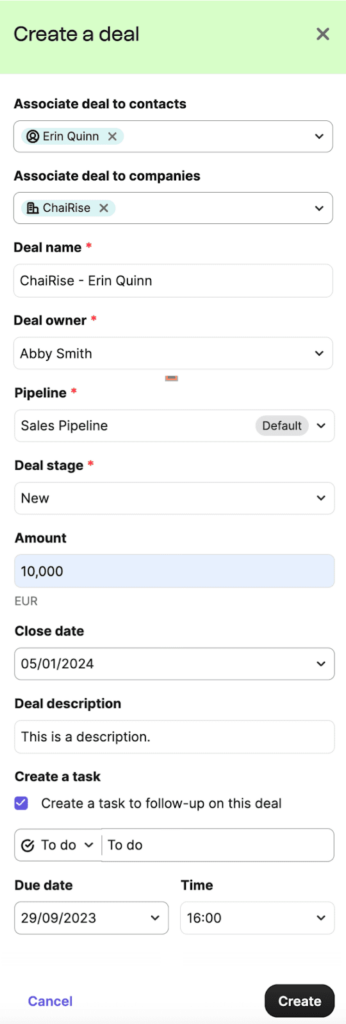
Creating a new deal in Brevo (manual process)
When you have multiple deals in your pipeline(s), you’ll be able to filter them by the estimated close date, responsible sales rep, and overdue tasks. It’s also a good idea to analyze your lost and won deals to better understand what works and what doesn't in your sales approach.
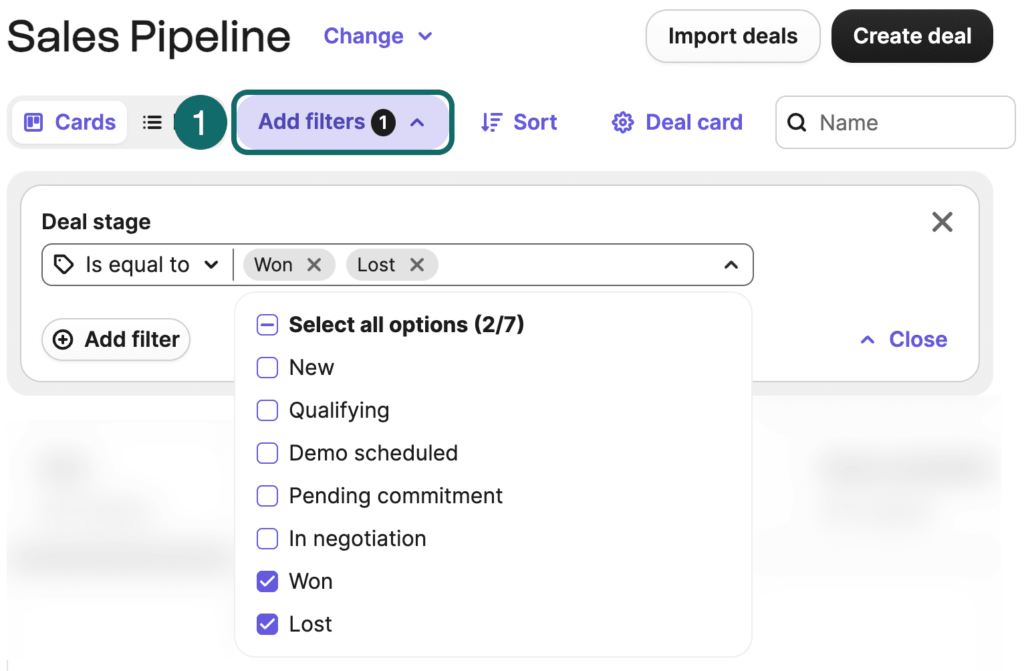
Filtering sales deals in Brevo
Here are a few more ideas for what you should pay attention to when analyzing your deals.
- Age of the deal. Are there deals that have been open for a long time? It could be that those prospects have already found the right vendors.
- The ratio of open deals in the sales pipeline. For instance, having 10 deals in the “negotiation” stage and zero new deals means you’ll have an empty pipeline next month.
Sales cycle
As your CRM system gathers data, it reveals patterns that expose your sales process' strengths and weaknesses.
One of the reports you should pay attention to in Brevo is the Sales cycle report. You can access it by clicking through Deals > Reports > Sales cycle report. This is where you can find historical data on the effectiveness of your sales process.
The report covers:
- Average win rate over a specified timeframe
- Conversion rates for each stage in the sales pipeline
- Breakdown of reasons for lost deals
- The average time to close a deal
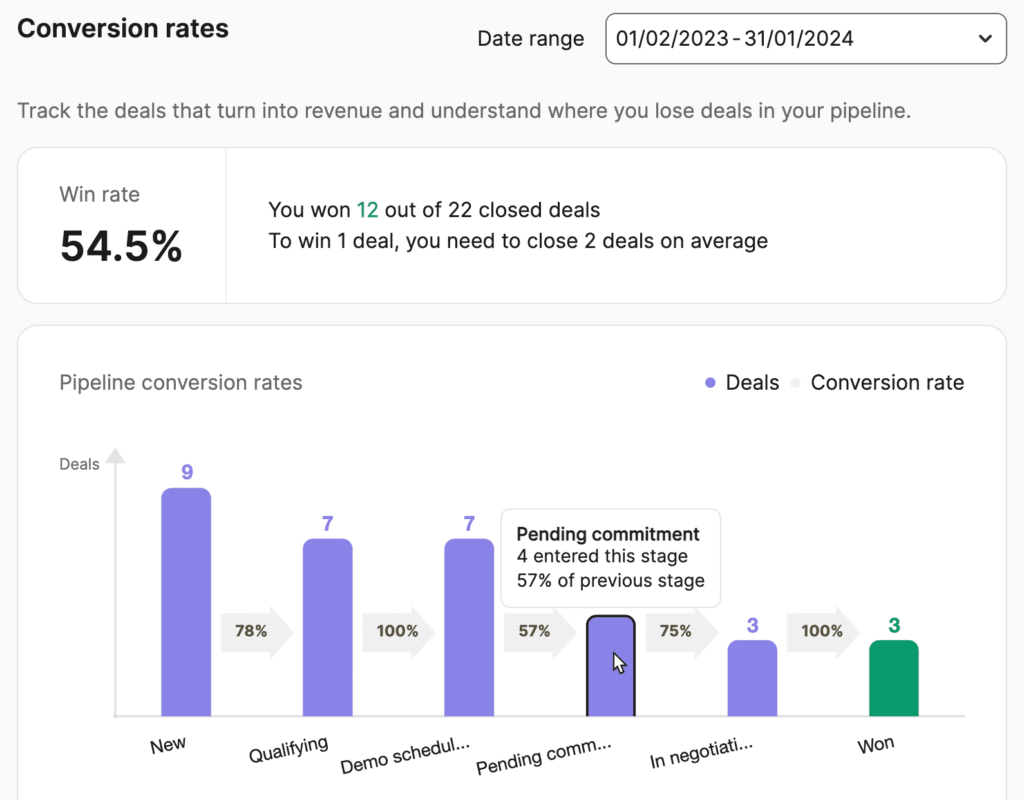
The sales cycle report in Brevo
Revenue
Our focus has been on the sales process, but let's shift attention to the bottom line — revenue. No matter how high your win rate is, if revenue goals aren't met, it's a reason to rethink your strategy.
Conveniently located next to the Sales cycle report, you'll find the Revenue report. Here, you’ll find two charts:
- Your revenue by date. See the total revenue, the number of deals closed, and the average deal value within a selected timeframe. Hover over points on the graph to reveal monthly breakdowns of deals and revenue won.
- Total deal value per pipeline stage. Get a snapshot of potential revenue in your pipeline. Hover over bars in the chart to see the total deal value and estimated revenue for each individual pipeline stage, along with the number of open deals.
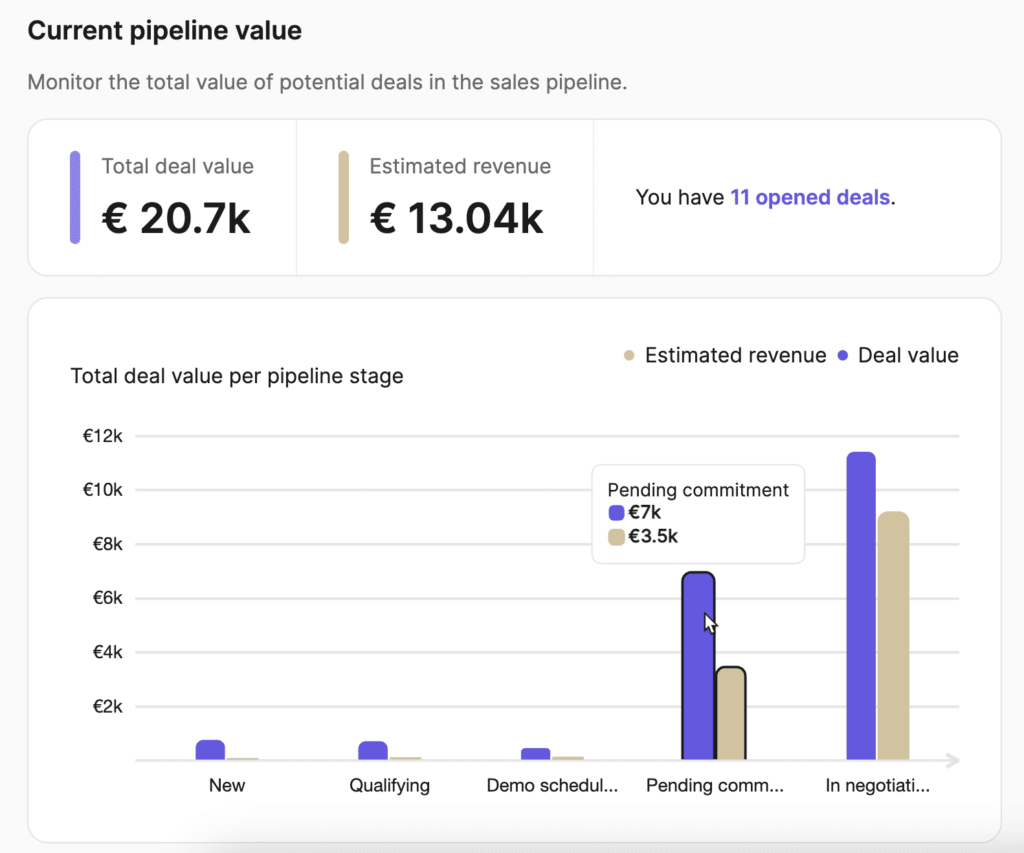
The current pipeline value report in Brevo
Estimated revenue is calculated based on the win probability that you specified for each pipeline stage. You can assess the accuracy of your sales forecasting by comparing your estimated revenue to actual closed deals.
If you consistently find a large gap, adjust your win probability estimates and revisit your sales strategy.
Further reading: How to Do Sales Forecasting in Excel
Team performance
Sales managers need to understand the strengths and weaknesses of individual team members. Who's bringing in the biggest wins? Who's spending the longest hours on deals? Tracking these sales metrics isn’t just about performance evaluations.
By diving into team performance data, you'll uncover insights that help you make smarter decisions. You can match a rep's skillset to specific types of deals, pinpoint where someone needs additional training, and most importantly, double down on your team’s strengths.
For instance, if a specific rep consistently outperforms others, you may analyze their approach and share those winning strategies across your team to drive overall success.
Most sales CRM platforms include features for individual sales rep reporting. In Brevo, the Team Performance report uncovers the following KPIs per sales rep:
- Average time to win
- Average won deal value
- Won deals
- Win rate
- Revenue share
- Revenue

Evaluating performance metrics for each team member
Further reading: 6 CRM Best Practices for Marketing & Sales Teams
5 Sales tracking software solutions
There’s a wide range of sales monitoring tools on the market. To help you out, we've highlighted the top five sales tracking solutions that cater to different business needs.
1. Brevo: the most approachable sales tracking software
Brevo is an all-in-one CRM suite with built-in sales tracking features designed to simplify the sales process. Its standout features for sales teams include:
- Contact activity tracking: Brevo displays an activity timeline, allowing you to see all your clients’ interactions with marketing, sales, and your site.
- Deal pipeline management: Get a clear overview of your deals across all stages of your sales pipeline. The drag-and-drop functionality makes it easy to move deals as they progress.
- Sales automation: Build workflows to automatically create new deals, send automated follow-ups, create tasks for your team members, and more.
- Video conferencing tools: Use Brevo’s native video-calling solution. Or connect Zoom, Google Meet, or any other platform of your choice.
- Cloud-based phone system: Manage your phone calls with the web calling interface or mobile app. You also get a free phone number in every plan.
- Shared (multichannel) inbox: Have all your messages from live chat, WhatsApp, email, and social channels in one place.
- Robust reporting tools: Track key metrics like conversion rates, revenue, sales cycles, team performance analytics, and more to make data-driven decisions.
- Seamless collaboration: Add notes, set up different logins for team members, assign tasks (manually or automatically), and sync easily on every deal.

Managing deals in Brevo’s Sales Platform
You get access to most of these features in Brevo’s free Sales Platform plan. The paid plan costs $12/month and includes unlimited deals and pipelines.
When you sign up for Brevo, you also get access to our marketing and CRM suites, packed with even more features to grow your business.
- Email marketing tools (a drag-and-drop email builder, templates, etc.)
- Customer relationship management (CRM)
- Signup forms
- Landing pages
- Transactional emails
- SMS marketing tools
- Web and mobile push
- WhatsApp campaigns
- Chatbot & live chat
2. Pipedrive
Pipedrive is a classic CRM solution with a focus on pipeline management (as its name suggests).
In Pipedrive, you can access the following features:
- Pipeline and deal management
- Team performance tracking
- Task management
- Contacts timeline
- Sales automation
- Revenue forecasting and reporting
- Email marketing tools
- Integrations with over 400 tools
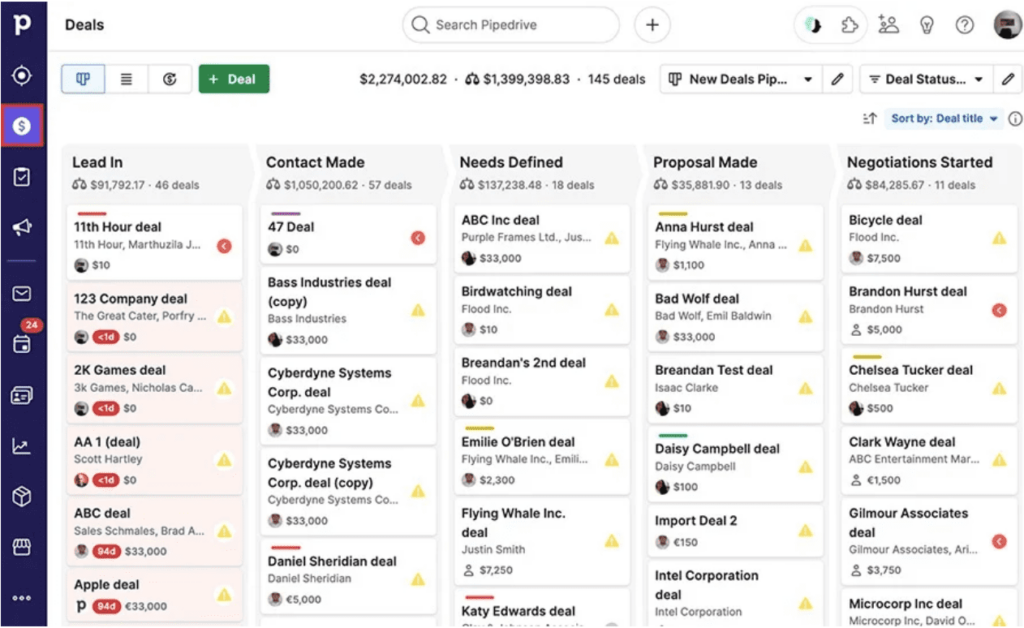
Pipeline management in Pipedrive
Pipedrive is often compared to Hubspot and Salesforce for its customization capabilities and attention to detail. Previous experience with CRM solutions is recommended.
Pipedrive's pricing falls between more expensive competitors and less popular budget-friendly options. While there's no free plan, their Essential tier starts at $14.90/user/month.
For features like sales automation and video scheduling, you'll need the Advanced ($27.90/user/month) or Professional ($49.90/user/month) plans, billed annually.
Mind that lead generation tools and email campaigns come as separate add-ons.
Further reading: 12 HubSpot Competitors for Email Marketing and Sales CRM
3. Gong
Gong is a revenue intelligence platform designed for high-performing sales forces. It offers robust call recording and analysis, along with a suite of other powerful sales tools:
- Sales pipeline tracking
- Forecasting
- Team productivity insights
- Revenue tracking
- Customer interactions monitoring
- AI-powered analytics
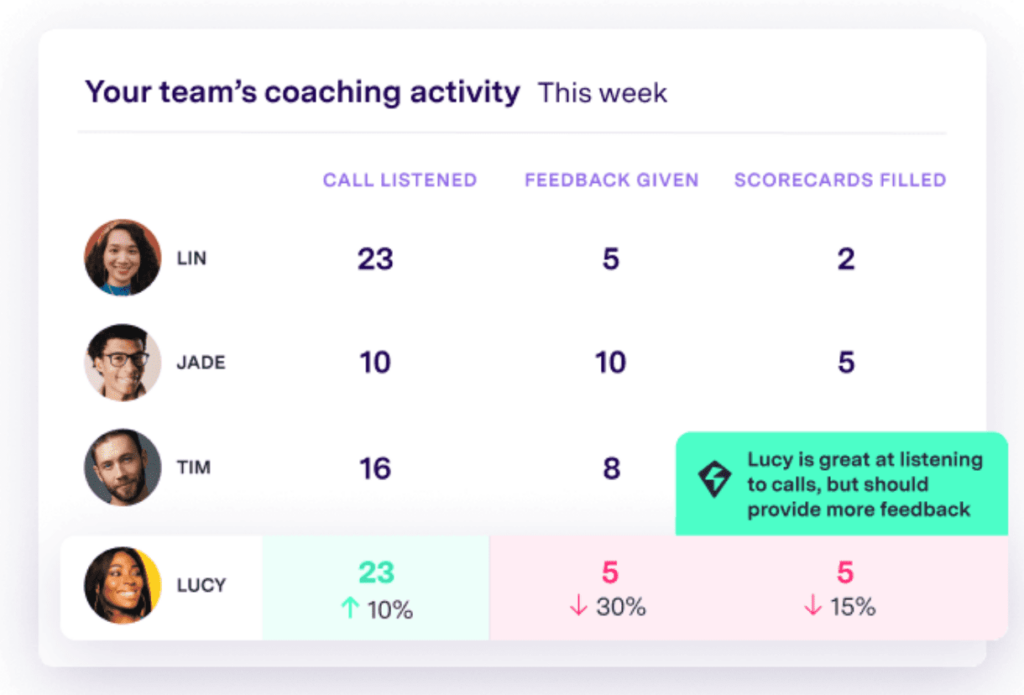
Sales rep coaching in Gong
Coaching for sales reps remains Gong’s strongest capability. The platform helps sales managers spot areas that need improvement across the team, showcase successful call examples, and create tailored coaching programs that address individual reps' unique needs.
All things considered, Gong is the right choice for those looking to build a powerful sales team and have a decent budget. While the company doesn’t disclose their pricing, you should expect to spend around a few thousand dollars per user a year.
4. Groove
Groove is a sales enablement platform for mid-market companies and enterprises that are already invested in the Salesforce ecosystem. If you have complex sales reporting, management, and compliance needs, Groove is right for you.
The platform makes Salesforce more user-friendly for salespeople by providing a more intuitive interface and automating repetitive sales activities within Salesforce workflows.
The combined power of Groove and Salesforce data offers more reliable sales tracking without relying on manual data entry by your sales reps. Here’s what else you get:
- Rep-level performance insights
- Automated flows
- Flow monitoring
- A/B testing
- Lead routing
- Call recording and transcription
- Sales rep coaching
- ROI reporting
- Integration with LinkedIn Sales Navigator
- AI-powered insights
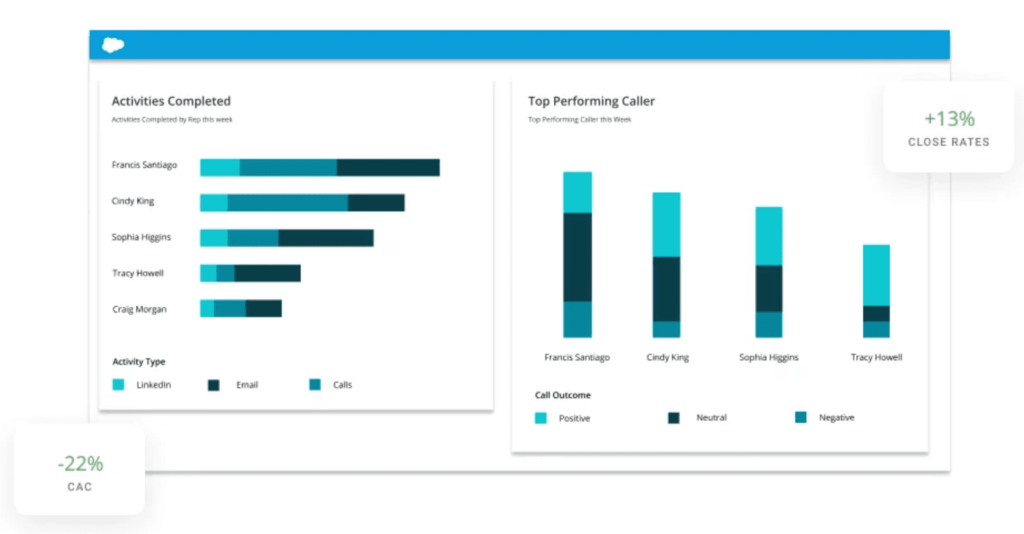
Team performance monitoring in Groove
Groove doesn't publish pricing information and focuses on tailored enterprise solutions. It's likely to be on the higher-end of the price spectrum compared to the previous tools.
4. ProfitWell Metrics
ProfitWellMatrics by Paddle is a revenue-tracking tool for subscription-based businesses. It's designed to simplify tracking your financial health and growth — no advanced data skills needed.
With the forever-free tool, sales teams and SaaS founders can track critical subscription KPIs and metrics such as:
- Monthly recurring revenue
- Churn
- Upgrades and downgrades
- Customer lifetime value
- Active customers
- Revenue per customer

Subscription business metrics tracking with ProfitWell
Why forever-free? ProfitWell Metrics is a part of the Paddle software suite. By offering a free version, they introduce subscription businesses to their powerful revenue-tracking tools.
To access Paddle's complete payment, tax, and subscription management features, you'll need to upgrade to a paid plan.
Further reading: Salesforce Alternatives: 9 Out-Of-The-Box CRM Tools
Get started with sales tracking
Before you dive into sales tracking dashboards, ask yourself: what exactly do you want to track?
Do you have a team, or are you a solo player? Do you need detailed revenue reports? Does your sales process have unique stages?
Thinking through these questions helps you pinpoint the right metrics and choose the best sales tracker that fits your needs. Once you have that foundation, you can confidently set up your reporting and focus on what matters most to you.
If you need a straightforward but elegant sales tracking solution, Brevo’s Sales Platform is the perfect place to start. Sign up for free to get unlimited contacts, a customizable pipeline, and 50 open deals.






